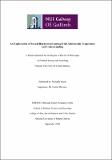| dc.contributor.advisor | Devaney, Carmel | |
| dc.contributor.author | Walsh, Michelle | |
| dc.date.accessioned | 2021-05-04T10:00:53Z | |
| dc.date.available | 2021-05-04T10:00:53Z | |
| dc.date.issued | 2020-10-01 | |
| dc.identifier.uri | http://hdl.handle.net/10379/16738 | |
| dc.description.abstract | There is a dearth of research relating to Irish adolescents’ experiences of sexual harassment RNCI (2014). The aim of this research study is to explore and give voice to Irish adolescents’ experiences and understanding of sexual harassment with their peer communities while giving consideration to the responses that may be required to address adolescent sexual harassment. Having considered various theoretical schools and approaches employed to understand adolescent development, Hall’s (1983) framework was employed to consider the biological, cognitive and psychosocial transitions occurring during this time. Erickson’s (1968) fifth stage of psychosocial theory was selected to discuss the challenges associated with identity development in order to navigate its implications for adolescents’ life trajectories.
Sexual harassment, and its existence within a continuum of behaviours (Moffitt et al., 1993) is expanded upon as well as the contribution of social norms and gender inequality in the continuance of adolescent sexual harassment. Bronfenbrenner’s (1979) ecological systems theory is utilized as a method to explore both the bi-directional and interconnected issues that contribute to adolescent sexual harassment at each level of their ecological system. The role parents, peer groups, school, bullying, social media are discussed along with the issues that exist within each of these systems.
Employing thematic analysis, the findings from this study are based upon utilizing mixed methods of data collection, comprising (n=599) quantitative questionnaires completed by adolescent participants in addition to a qualitative section comprised of (n=93) adolescent and (n=21) youth worker interviews. A combination of descriptive statistical and inferential analyses was used to analyse the quantitative data within this study. The study found that Irish adolescents are experiencing high levels of sexual harassment. Social norms and gender inequality are two major contributing factors, along with a lack of adequate RSE within educational settings. Additionally, there are few supports available to those who have experienced sexual harassment. Based on these findings, an ecological framework for understanding and responding to adolescent sexual harassment has been developed. It is intended that this framework can be employed by academics, policy makers and at a practice level to understand and implement strategies in response to the key issues outlined within this research study. | en_IE |
| dc.publisher | NUI Galway | |
| dc.rights | Attribution-NonCommercial-NoDerivs 3.0 Ireland | |
| dc.rights.uri | https://creativecommons.org/licenses/by-nc-nd/3.0/ie/ | |
| dc.subject | Adolescent, | en_IE |
| dc.subject | sexual | en_IE |
| dc.subject | harassment | en_IE |
| dc.subject | ireland | en_IE |
| dc.subject | understanding | en_IE |
| dc.subject | experiences | en_IE |
| dc.subject | Arts, Social Sciences and Celtic Studies | en_IE |
| dc.subject | Politcal Science and Sociology | en_IE |
| dc.subject | Sociology | en_IE |
| dc.subject | Child and Family Research | en_IE |
| dc.title | An exploration of sexual harassment among Irish adolescents: Experience and understanding | en_IE |
| dc.type | Thesis | en |
| dc.local.note | There is a lack of information about Irish adolescents experiences and understanding of sexual harassment. This study addresses this lack of information and give an overview of the issues experienced by Irish adolescents and their understanding of those expereinces | en_IE |
| dc.local.final | Yes | en_IE |
| nui.item.downloads | 120 | |


